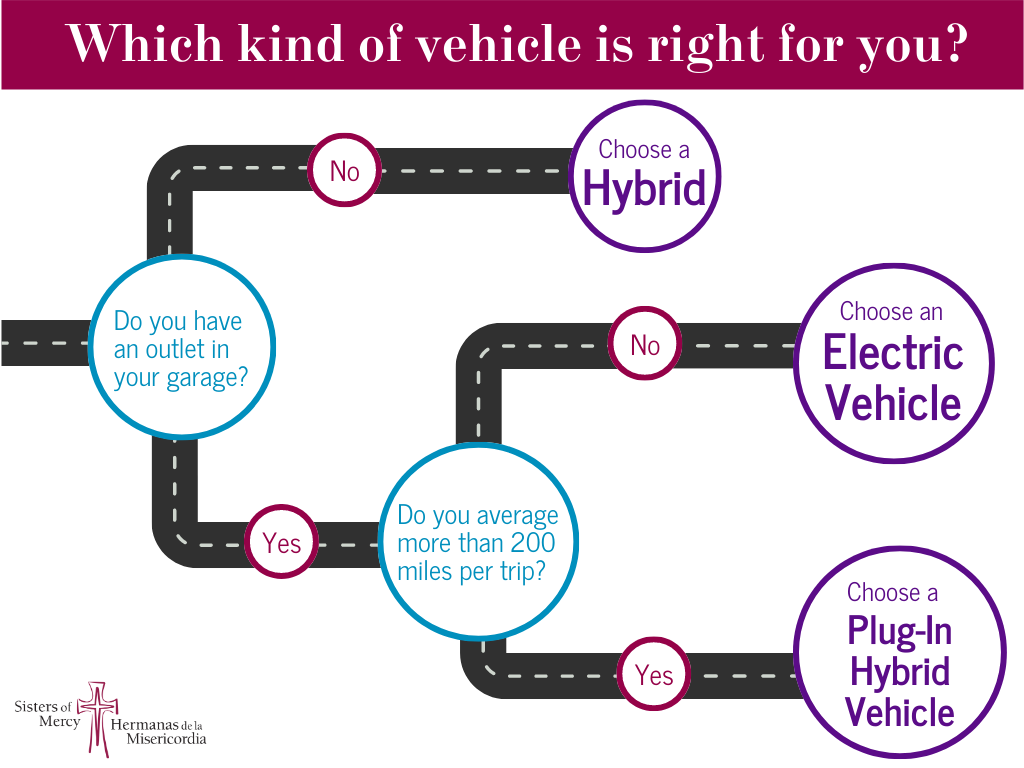by Jason Giovannettone, Climate and Sustainability Director, Sisters of Mercy of the Americas
The two major sources of greenhouse gas emissions for the Sisters of Mercy of the Americas come from energy and vehicle use. Switching to an electric, hybrid or plug-in hybrid vehicle could substantially reduce your emissions.
When switching from a fully gas-powered to an electric, hybrid or plug-in hybrid vehicle, there are many items that need to be considered.
A hybrid vehicle has the standard internal combustion engine that you would find in any fully gas-powered vehicle, but it tends to be much smaller because a hybrid is also powered by one or more electric motors that use energy stored in batteries. When the charge of the battery goes down or extra power is needed, the gas-powered motor will take over. The battery is then recharged whenever the brakes are pressed. The combined use of a gas-powered and an electric motor allow the vehicle to have a much higher fuel mileage than a standard vehicle powered solely by gas. For example, a Toyota Prius can get up to almost 60 miles per gallon compared to a standard gas-powered vehicle, which often has a fuel mileage of less than 30 miles per gallon. There is no difference in the driving experience between a hybrid and a fully gas-powered vehicle except that you will spend less time filling up at gas stations.
In contrast to a hybrid vehicle, an electric vehicle (or EV) is fully powered by energy stored in a battery and thus produces zero emissions while being used. Even though an EV requires no gasoline, it does require that the battery remain charged, which, unlike the hybrid, cannot be accomplished by using the brakes. Owning an EV requires an internal structure at home that contains an outlet for charging. If you are traveling distances longer than 200 to 300 miles, which is the common range of most EVs, you will also need to find a location at which to charge your vehicle. On the West and East Coasts, this may not be a big issue as there are many locations that offer charging stations; if you are traveling away from the coasts, though, it may be more challenging. As more charging stations are installed throughout the country, this will become less of a concern. It can take several hours to charge an EV when using a standard outlet. Some higher-level chargers can fully charge a battery in 30 minutes to 2 hours, depending on the vehicle. Though an EV does not create emissions while being used, significant emissions can be realized from charging your vehicle. This may not be a big issue near the East and West Coasts where a higher percentage of energy comes from renewable sources; in the central portion of the country the high use of fossil fuels can increase emissions from charging almost to the point where there is not significant savings when compared to a fully gas-powered vehicle.
The third and final option when considering an electric-powered vehicle is a plug-in hybrid vehicle (PHV). A PHV will run completely on electricity for the first 25 to 45 miles, after which it will run as a regular hybrid. In order to take advantage of this capability, you will still need an indoor outlet at home in order to charge the battery overnight. However, when traveling far from home, you do not need to find a charging station. If you keep the PHV charged at home and typically travel less than 25 to 45 miles per trip, you will use almost zero gasoline. In fact, one sister who is currently using a PHV reported an average of 114 miles per gallon.
Green Tip:
When requesting your next vehicle, consider a hybrid, plug-in hybrid, or a fully electric vehicle. Consider the following questions:
- How many miles do I drive in an average year? (The more miles you travel, the more benefit to owning a hybrid or electric vehicle)
- Does my residence have a garage with an outlet? (Yes – electric & plug-in hybrid; No – hybrid)
- How far do I typically travel from home per trip? (closer to home – electric & plug-in hybrid; farther from home – hybrid).
- Do I live in an area where there are plenty of charging stations available away from home? (Yes – electric; No – plug-in hybrid & hybrid).
